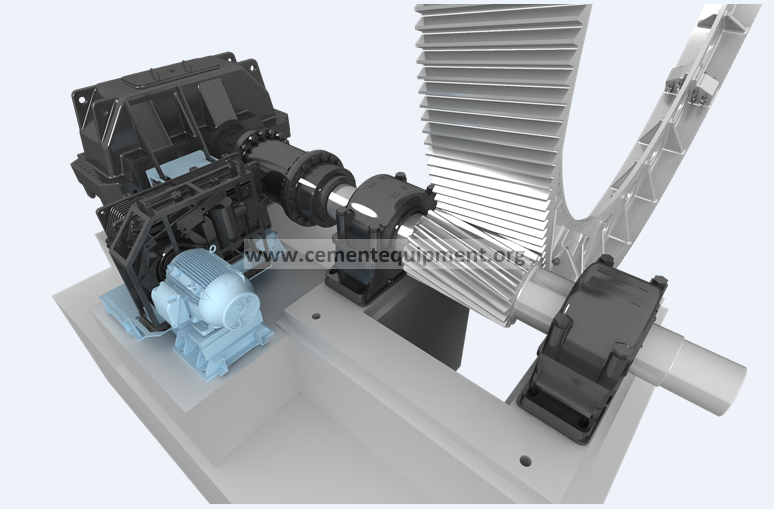Contents
Everything you need to know about Middle East Standards and Specifications for Cements
[wpecpp name=”package” price=”75″ align=”center”]
by Sayed Horkoss*
Cementitious materials have been used in the Middle East for several millennia. History tells us that a cementing material was used between the stone blocks during the construction of the great pyramids at Giza in ancient Egypt around 2500 B.C. proving that cement has been a critical product for Middle East inhabitants for a very long time.
The evolution of the cement industry in the modern Middle East was started by the Europeans in the early 20th century with the help from local investors, primarily because of the abundance of cement raw materials in most of the Middle Eastern countries. Consequently, the development of cement standards also started during the middle of 20th century. Initially, although each country had its own standards and specifications, they were based mainly on the British Standards. However, between 1997 and 2003, due to large economic investments in the production and marketing of cement, many Middle Eastern countries started to export cement, mainly to Europe.
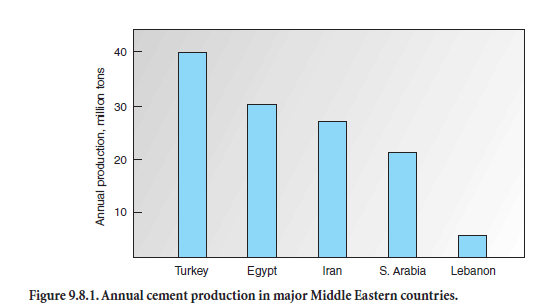
For this reason, cement manufacturers were obliged to produce cement in accordance with the European norm EN 197 requirements.
This chapter discusses the production of portland cement: the types, standards, and specifications being used by the major cement–producing countries of the Middle East such as Turkey, Iran, Egypt, and Saudi Arabia. The annual cement production in these countries is shown in Figure 9.8.1. The author has also included Lebanon in the list because of the Cimenterie Nationale Company that uniquely operates on 100% pet coke with high sulfur content (5% to 6%) and successfully controls sulfur in the end product.
CEMENT PRODUCTION IN TURKEY
The Turkish cement industry is the largest in the Middle East; it operates 57 cement plants and post an annual production of nearly 40 million tons (Table 9.8.1). The bulk of the cement produced in Turkey (almost 90%) is consumed domestically; the rest is exported.

EVOLUTION OF TURKISH CEMENT STANDARDS AND SPECIFICATIONS
Standard Number 6/640
The Turkish government first developed a cement standard designated as Number 6/640 in 1959. This standard covered the specifications for different portland cements, slag cements, and pozzolanic cement produced in Turkey (see Table 9.8.2a). Their chemical and physical specifica-tion and performance requirements are given in Table 9.8.2b.

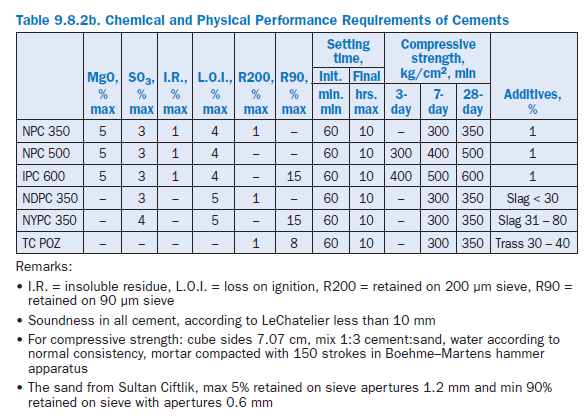
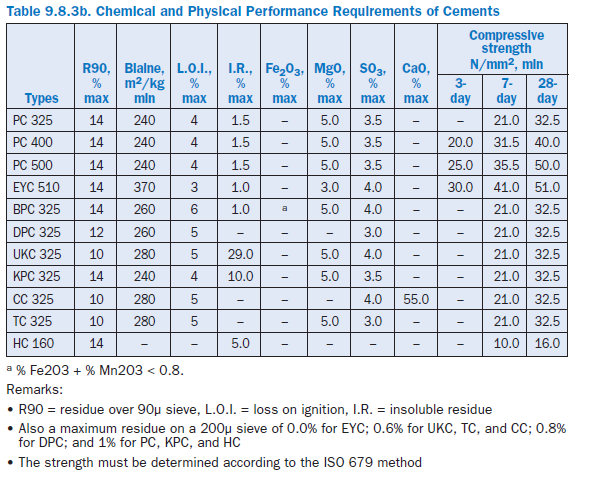
New Standards as per 2000 (EN 197)
Since 2000, Turkey has completely changed the cement standards and adopted the European stan-dard EN 197 using cement Types CEM I, II, III, IV, and V. These standards also allow the use of a new kind of additive such as limestone. Additionally, there are new chemical, physical, and mechanical testing methods with these standards. The 11 Turkish cements are now classified into the main types. EN197 types and their major constituents are addressed in the chapter on European Cements.
This new standard describes clearly the quality of the additives to be used. Additionally, the European Standard EN197 specifies the scheme for the evaluation of conformity of cements to their corresponding product specification standards, including certification of conformity by the certification body.
The standard provides technical rules for production control by the manufacturer, including auto-control testing of samples, and for the tasks of the certification body. It also provides rules for action to be followed in the event of nonconformity, the procedure for certification of conformity, and the requirements for dispatching centers.
CEMENT PRODUCTION IN EGYPT
Egypt is the largest cement producer country on the African continent. The oldest operating company in Egypt is Tourah Portland Cement which was commissioned in 1929 and has a capacity of 3.7 million/year. The most recent plant is that of Misr Beni Suef Cement, which was commissioned in 2001 and has capacity of 1.4 millions tons/year. In total, Egypt has 12 cements plants with a combined production of more than 30 million tons as of the year 2002. Egypt’s cement plants have a total of 42 kilns of which 18 operate on wet process and 24 are dry process. There are also 3 white cement kilns. Eight more cement plants with an annual production capacity of around 9 million tons are under construction in Egypt.
Cement Standards and Specifications in Egypt
The types and designations of cements produced in Egypt and their standards and specifications based on physical, chemical, and performance requirements are shown Tables 9.8.4a, 9.8.4b, 9.8.4c, and 9.8.4d.
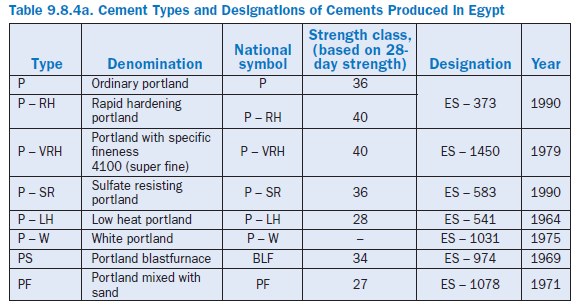
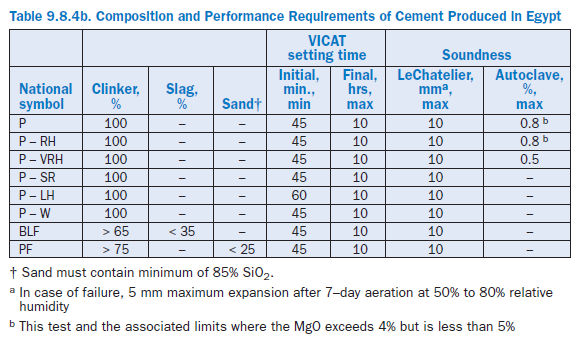
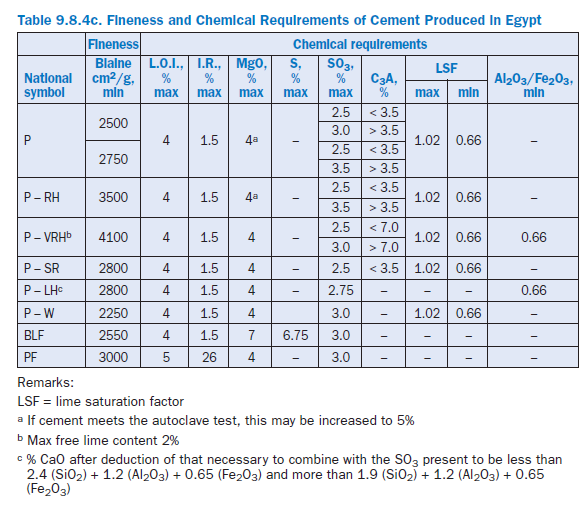
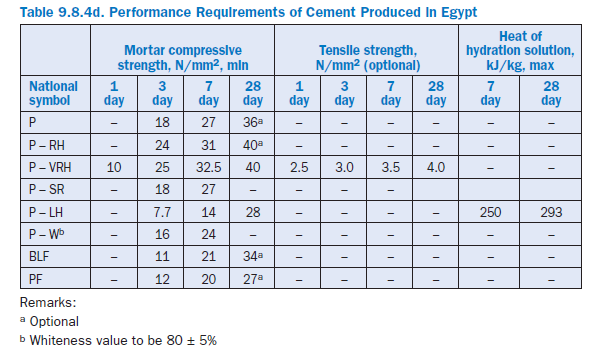
CEMENT PRODUCTION IN IRAN
There are currently 35 operating plants in Iran, and about 18 new cement projects are underway. The capacity of the existing plants (including white cement) is over 28 millions tons per year.
The first Iranian cement plant was constructed over 65 years ago in Rey in southern Tehran with the capacity of 100 t/d; the machinery for this shaft kiln plant was from F.L. Smidth of Denmark. Later, cement plants were established in Shiraz, Doroud, and many other parts of Iran. Currently, the cement companies are run by the National Iranian Industries Organization (NIIO).
Due to the access available from Saudi Arabia and the countries on the southern side of the Gulf, the Iranian cement industry seems to be facing regional competition. Therefore, in 1998 the Iranian Ministry of Industry permitted some private companies to invest in establishing cement plants. As a result, over 20 new cement projects were initiated to aim for an annual cement produc-tion of over 40 million tons in Iran.
Cement Standards and Specifications in Iran
The types and designations of cements produced in Iran, along with their standards and spe-cifications based on chemical composition and physical requirements, are shown in Tables 9.8.5a and 9.8.5b.
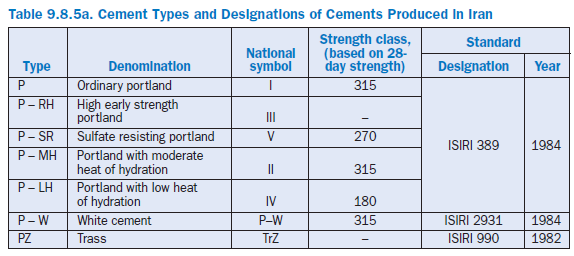
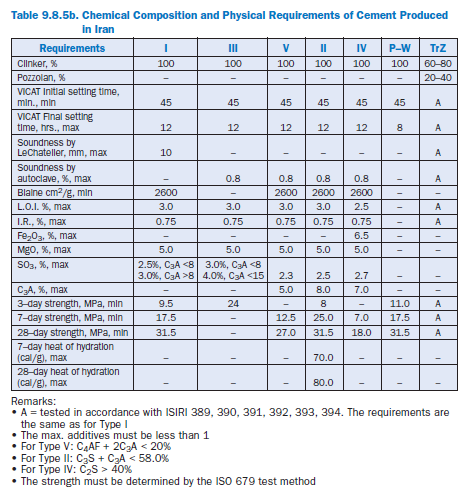
CEMENT PRODUCTION IN SAUDI ARABIA
Saudi Arabia is the largest cement producer in the Arabic Gulf area. There are eight cement plants which produce over 23 millions tons per year. The bulk of this cement (nearly 90%) is consumed locally, and the remaining is exported. The annual production of cement (and also clinker) in Saudi Arabia for the years 2001 and 2002 is shown in Table 9.8.6.
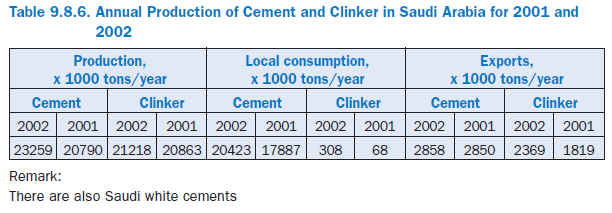
Cement Standards and Specifications in Saudi Arabia
The types and designations of cements produced in Saudi Arabia and their standards and specifications based on physical requirements and chemical composition and shown Tables 9.8.7a, 9.8.7b, and 9.8.7c.
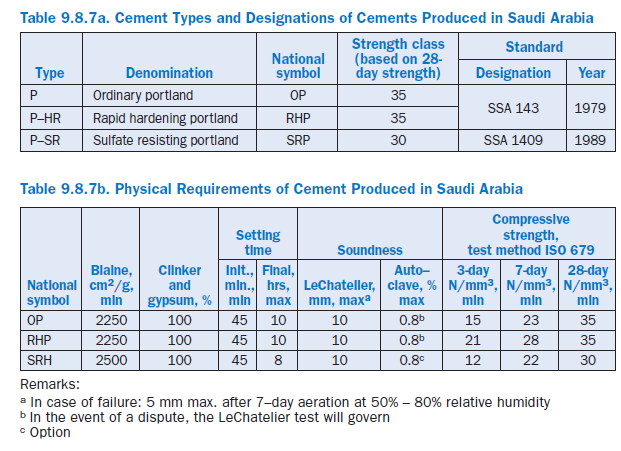
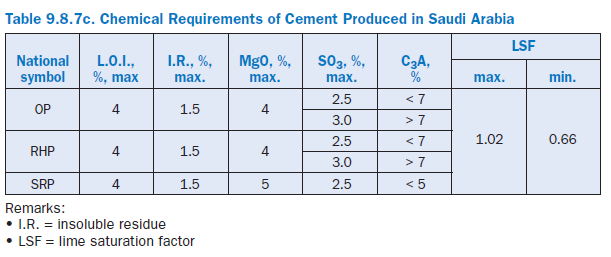
CEMENT PRODUCTION IN LEBANON
There are four major cement plants operating in Lebanon with an annual production capacity of cement close to 4.5 million tons. One of the oldest cement production plants in the Middle East was commissioned in Chekka, northern Lebanon in 1929; this plant was renamed in 2002 as Holcim Liban. There are seven major types of cement produced in Lebanon; they include ordinary portland cement and cement composite with limestone, pozzolan, fly ash, and slag (the two classical products in the market are portland cement and the composite with limestone).
Cement Standards and Specifications in LEBANON
In 1965 LIBNOR* published the first cement standard in Lebanon. This standard, known as NL 25:1965, was based on the British Standard BS 12:1958. It only covered one product called Normal Portland Cement 260/160 and specified its basic chemical and physical requirements as shown in Table 9.8.8.
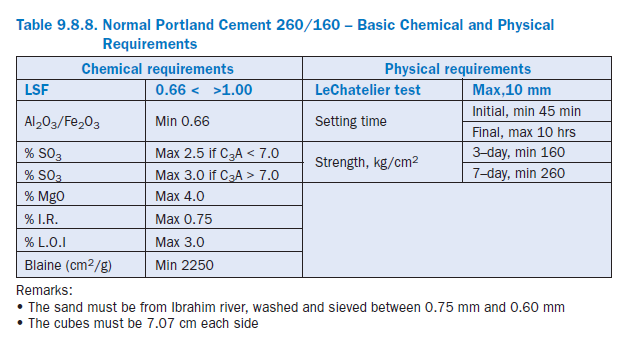
Under the supervision of LIBNOR a new standard was published in 1999 and named as NL 53:1999. This standard takes into consideration the requirements of local and international clients. It is based on a combination of the European Standard EN 197 and ASTM Standard C 150. The physical requirements and classes of cements are based on the European Standards, whereas the chemical requirements are based on ASTM C 150, especially for such cements as high sulfate resisting, moderate sulfate resisting, low heat of hydration, low alkali cements, etc.
Different cement types produced in Lebanon and their designations and composition are given in Table 9.8.9a. The cements are further divided into classes based on early and late strengths as shown in Table 9.8.9b. The specifications of Lebanese cements based on their chemical and physical requirements are shown Table 9.8.10.
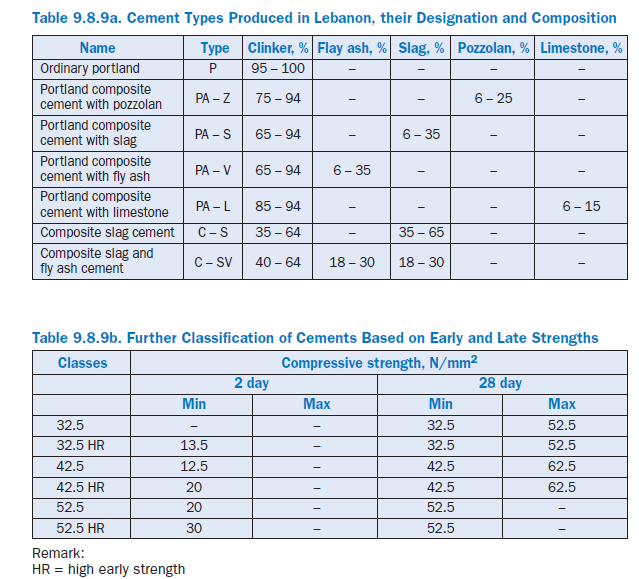
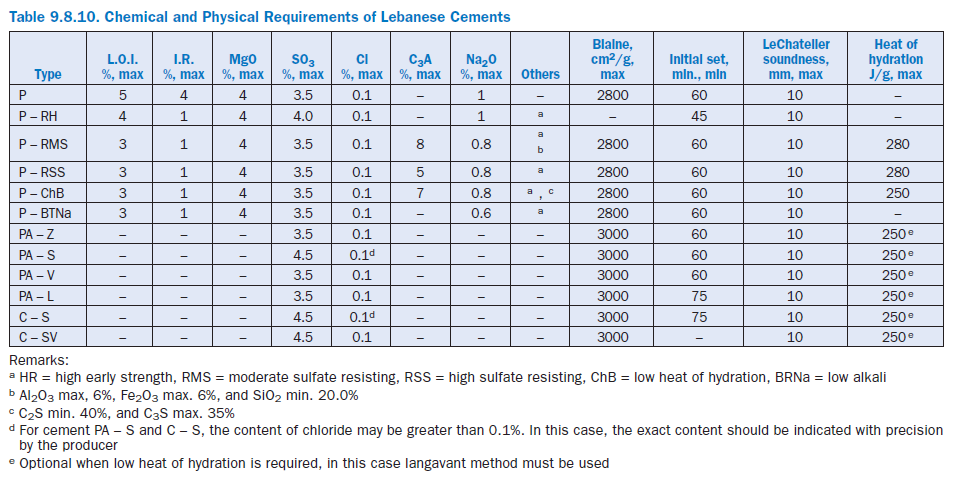
REFERENCES
Cement Standards in Egypt, ES-373, 1450, 583, 541, 1031, 974, and 1978.
Cement Standards in Iran, ISIRI 389, 990, and 2931.
Cement Standards in Lebanon, NL 25:1968 and NL 53:1999
Cement Standards in Saudi Arabia, SSA 143 and 1409.
European Cement Association, “Cement Standards of the World,” Brussels, 1991.
European Cement Association, “Cement Standards of the World,” Paris, 1968.
European Standard EN197.
Portland Cement Association, “Design and Control of Concrete Mixture,” 14th edition.
